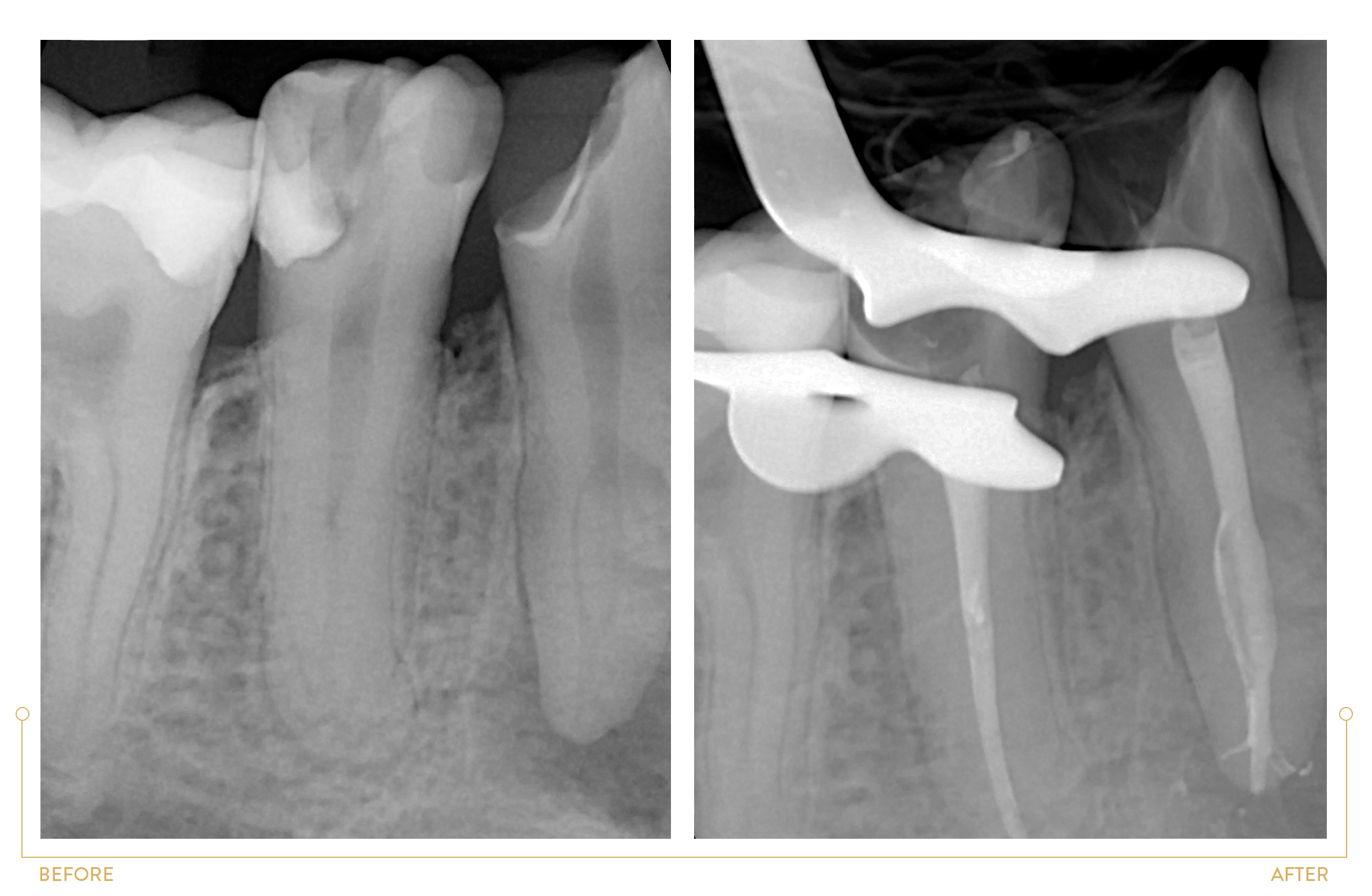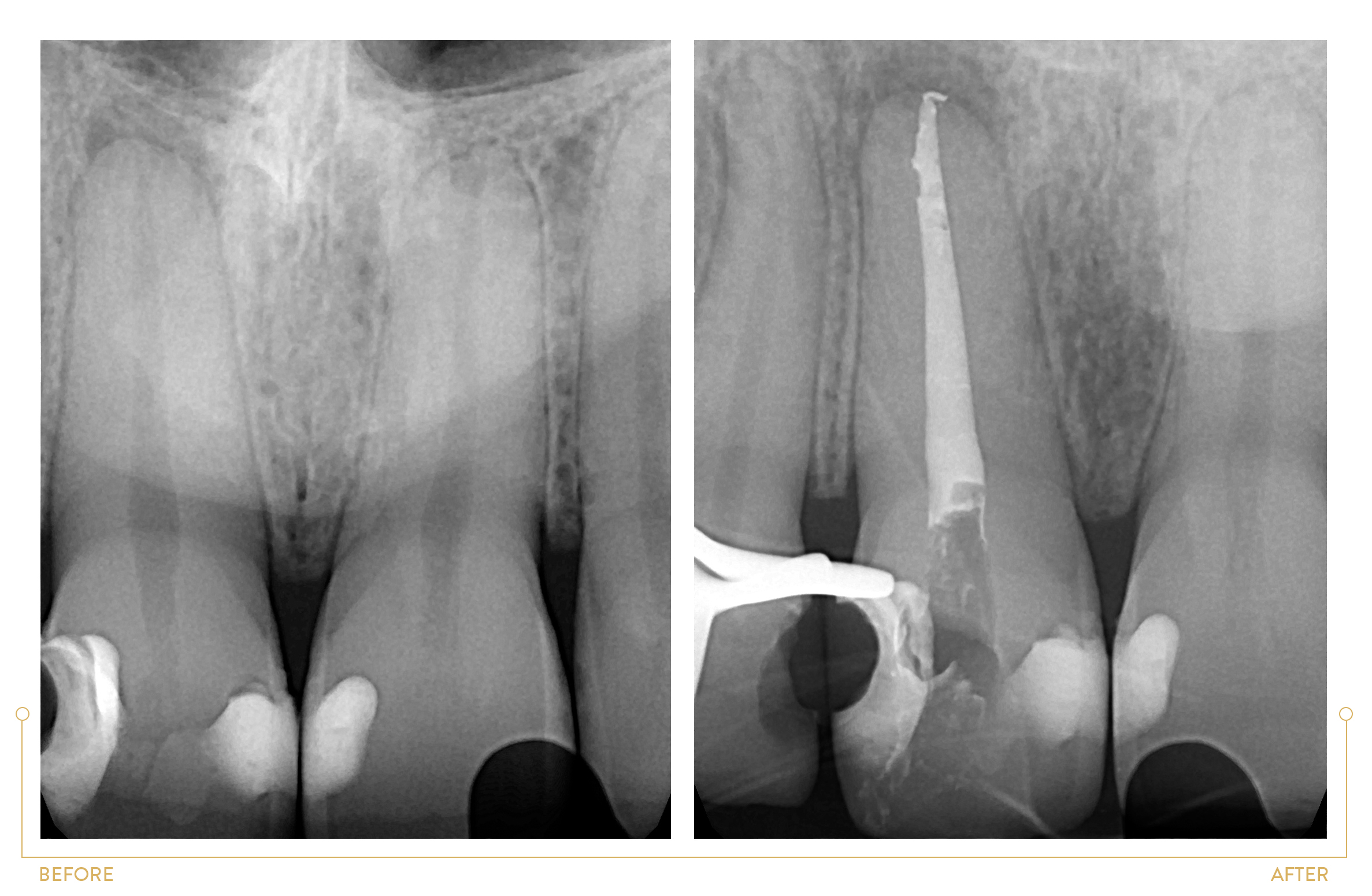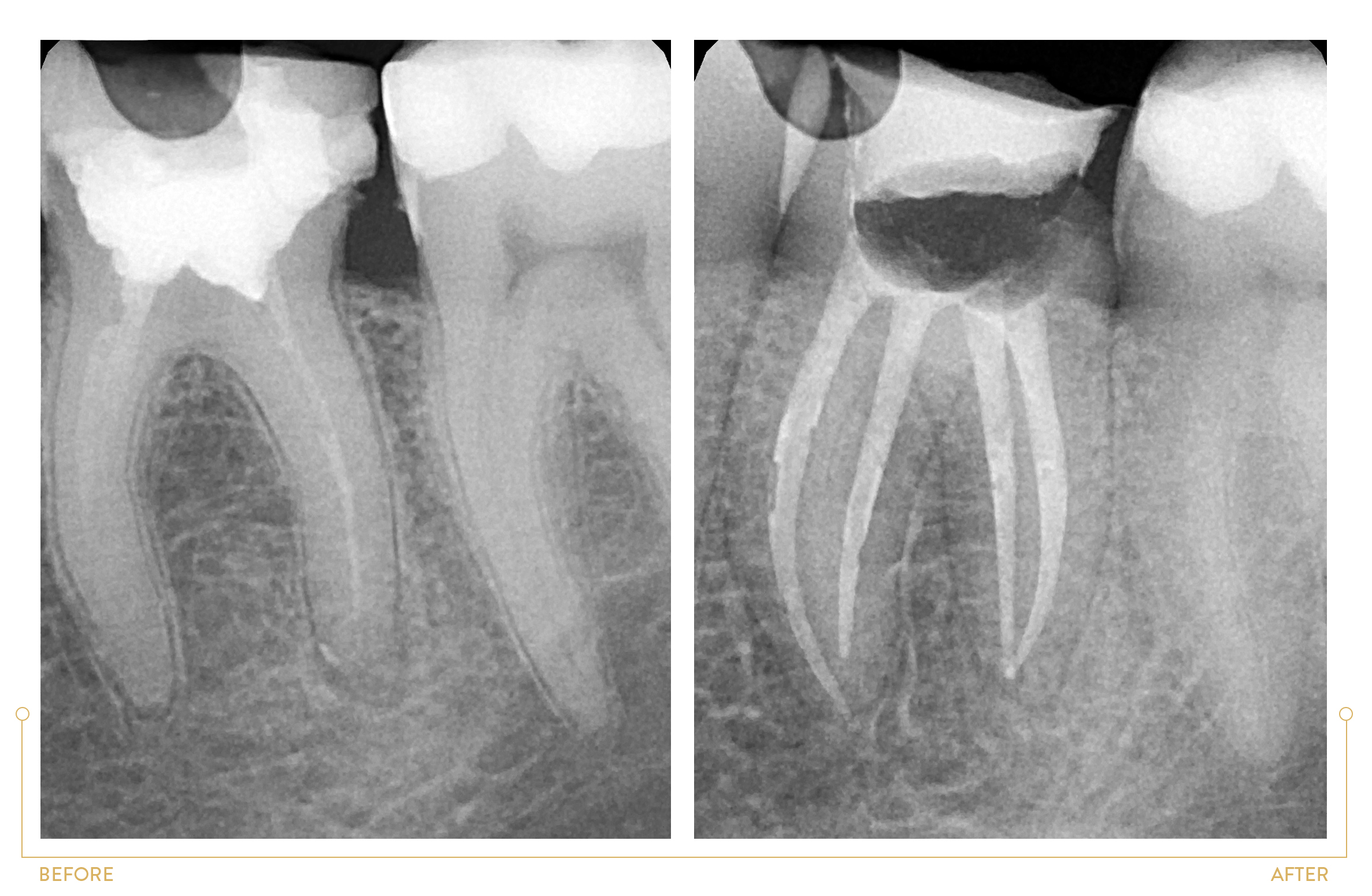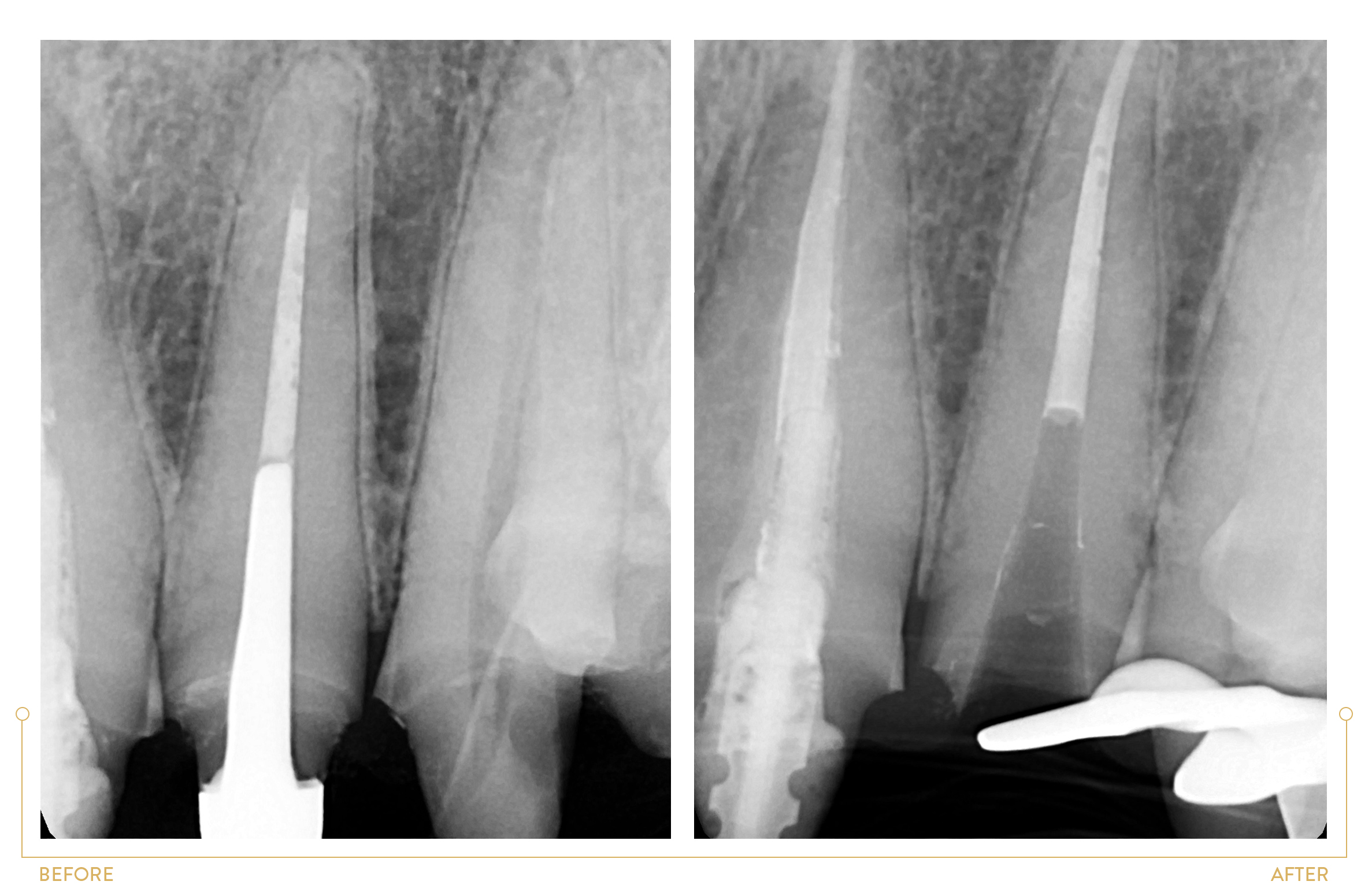Microscopic endodontics – basic information

INFLAMED TOOTH
Endodontic treatment, commonly known as „root canal treatment”, aims to neutralise disease processes developing in the root of the tooth by removing the pulp, dilating the canal and tightly filling the root canal system.
Infection of the pulp of the tooth can occur in the following cases:
- fractured tooth
- deep and extensive cavity
- repeated tooth treatments
- broken tooth
Untreated pulp infection can lead to numerous painful complications, including abscess formation. Root canal treatment is often the only way to preserve a tooth and requires experience and extensive medical knowledge.
Disturbing symptoms, requiring an immediate visit to the dentist, are:
- spontaneous or pulsating pain, persisting for a long time
- hypersensitivity to heat and cold
- feeling pain while biting
- extensive carious cavity
- dark tooth colour
- swelling and pain in the mucous membrane and surrounding soft tissues
Root canal treatments – types
Contemporary endodontics makes it possible for the doctor to accurately diagnose and provide precise and painless treatment. Before, during and after treatment a test is performed using radiovisiography (RVG). For more detailed analysis and diagnostics, computed tomography tests (CBCT) are sometimes necessary.
Using a high-class surgical microscope, the endodontist is able to assess the anatomy of the root system with the precision of a watchmaker, guaranteeing more effective treatment. This makes it possible to cure teeth that previously might have required removal due to the complicated construction of the root canal system or inadequacies of the original treatment (broken duct tool, perforation).
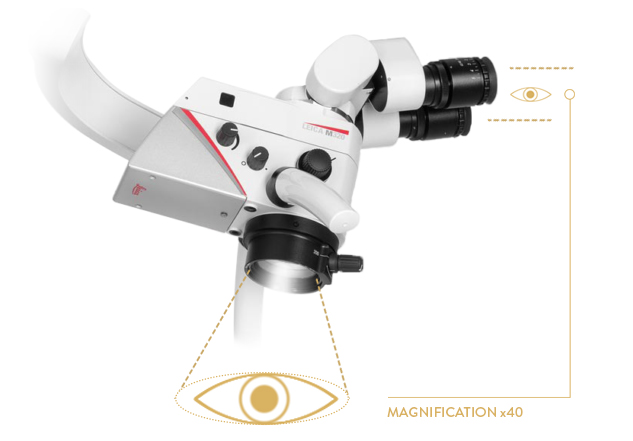
MODERN MICROSCOPE PROVIDING magnification ×40
Endodontic treatment – primary root canal treatment that aims to neutralise disease processes developing in the root of the tooth by removing the pulp.
Examples of correctly performed endodontic retreatment
Endodontic retreatment – repeated root canal treatment is necessary in cases where the tooth has already been treated with root canal treatment. Indications:
- incorrectly or inaccurately filled canals
- canals with infected pulp left behind
- teeth that have undergone a pulpectomy
- canals with instruments left behind
- chronic inflammation around the root
Examples of correctly performed endodontic retreatment
At the Cichoń Dental Centre, we can treat even the most serious cases. Below we present a tooth that had previously qualified for removal. The picture shows extensive inflammation and numerous perforations of tooth roots caused by a fibreglass insert. The rescued tooth has been serving the patient for many years now.

DIFFICULT PERFORATION TREATMENT
The course of root canal treatment
Before surgery, an examination takes place using radiovisiography (RVG) or (for more precise diagnosis) computed tomography (CBCT). On the basis of the examination, the dentist can make an appropriate diagnosis and determine the number of roots in the tooth, as well as their shape and course. The patient then undergoes anaesthesia.
The doctor protects the treated tooth with a special cofferdam, so that during the procedure no irritants enter the oesophagus. The first stage of treatment is cleansing the tooth crown of caries and preparing the tooth walls to facilitate access to root canals. The dentist then proceeds to the most important part of the procedure – removing the infected pulp from the infected canals.
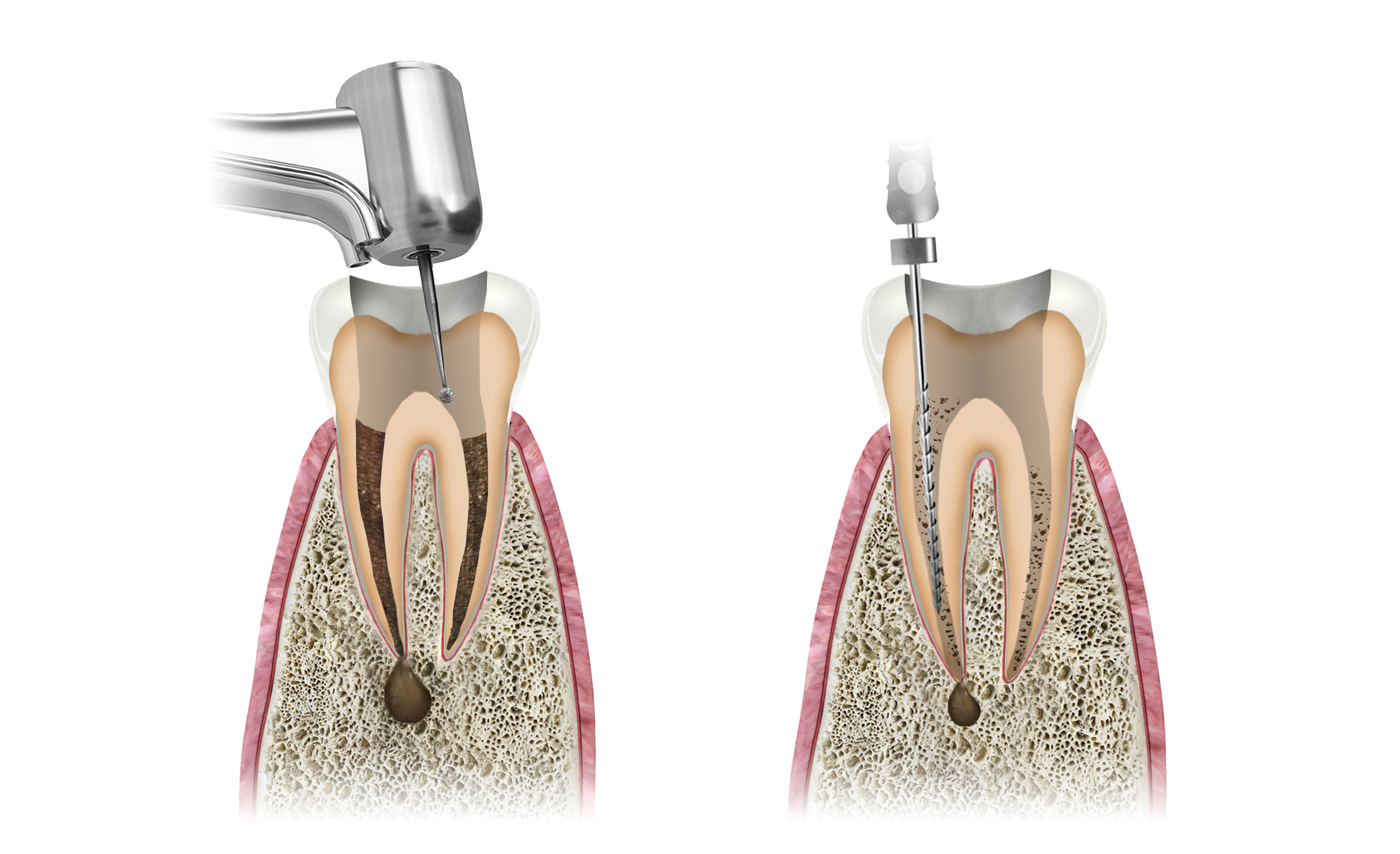
1. Cleaning the tooth crown and removing the infected pulp
Chemomechanical treatment of canals using an endodontic micromotor and cofferdam isolation makes it possible to significantly shorten the duration of the procedure, as well as influence the success of the treatment. Tight filling of the canals using thermoplastic gutta-percha makes it difficult for periapical tissues to become re-infected.
The purpose of filling after endodontic treatment is to restore the function and aesthetics of the tooth and prevent it from fracturing. After canal treatment, teeth can break as a result of a loss of mechanical strength due to the reduction of the number of hard tissues. In order to strengthen the endodontically treated tooth, fibreglass inserts are used.
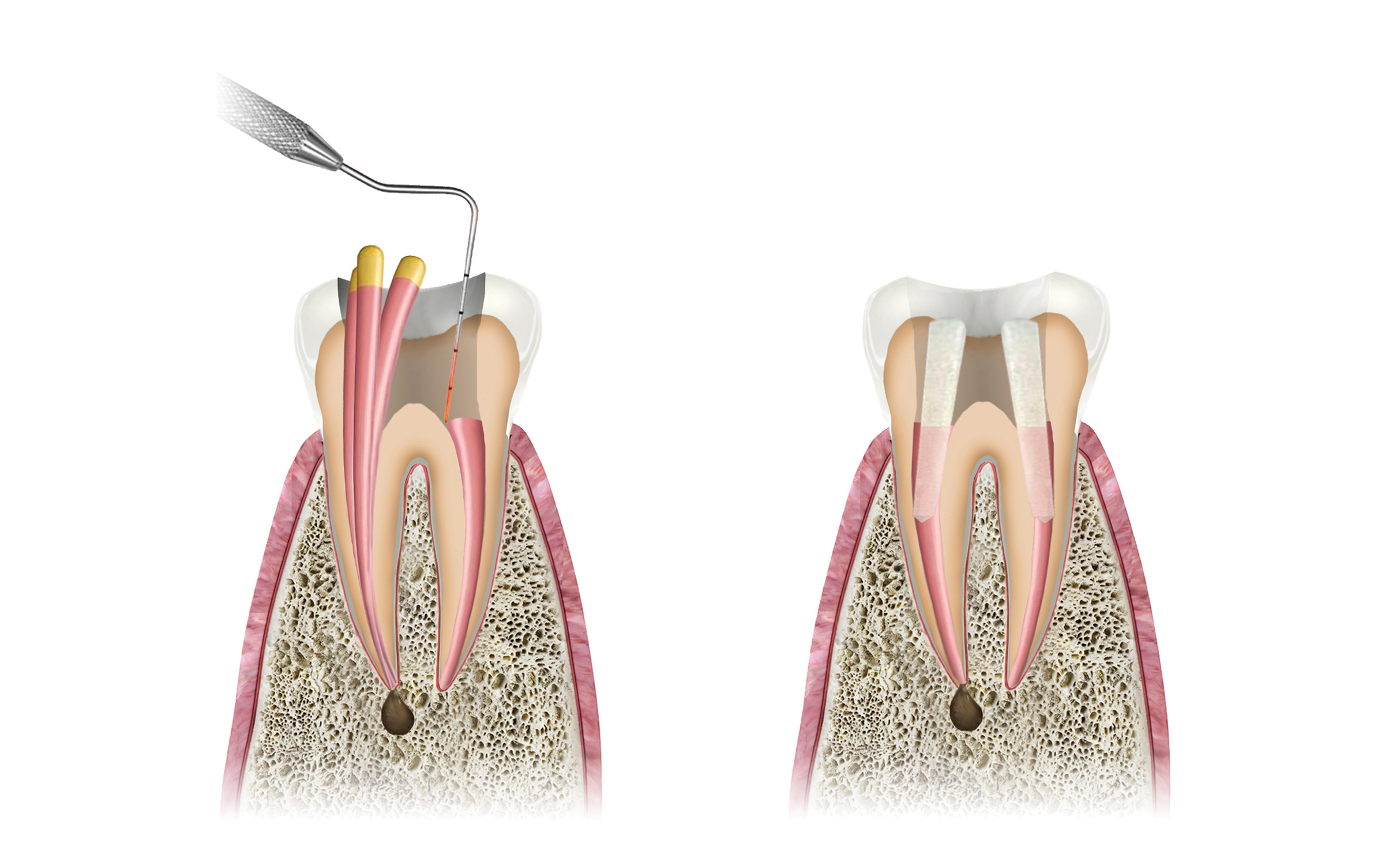
2. ROOT FILLING WITH GUTTA-PERCHA AND PLACEMENT OF GLASS FIBre INSERT
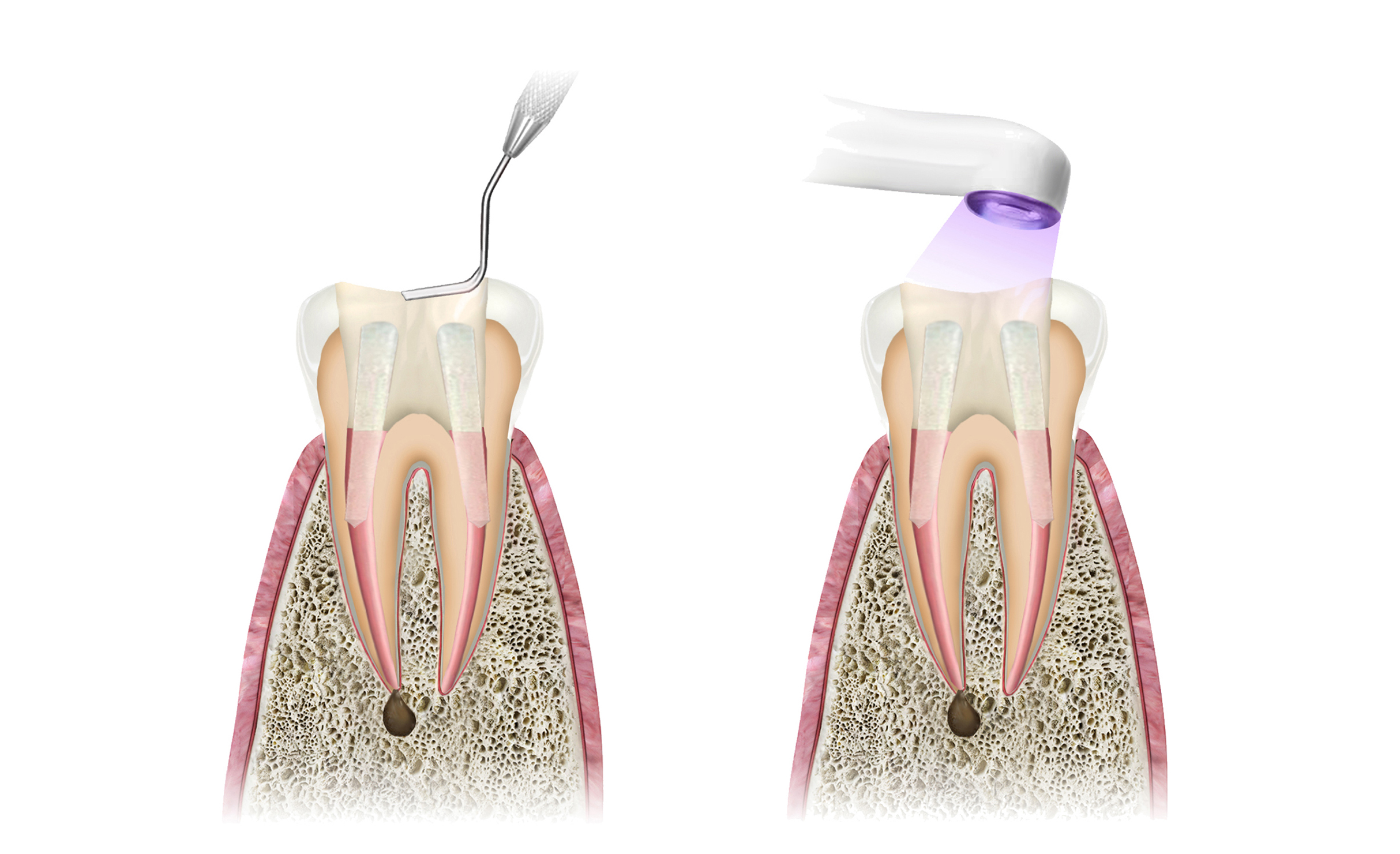
3. CEMENTING AND POLYMERISATION
After the endodontic treatment, the next stage is the reconstruction of the damaged tooth. Depending on the degree of damage to the crown, there are several options for rebuilding the defect. For minor damage, the solution is performing restorative reconstruction with a light-curing filling. In cases of more significant damage, the preferred form of reconstruction is a crown insert – OVERLAY (composite or ceramic), or reconstruction using a crown-root insert and a prosthetic crown.
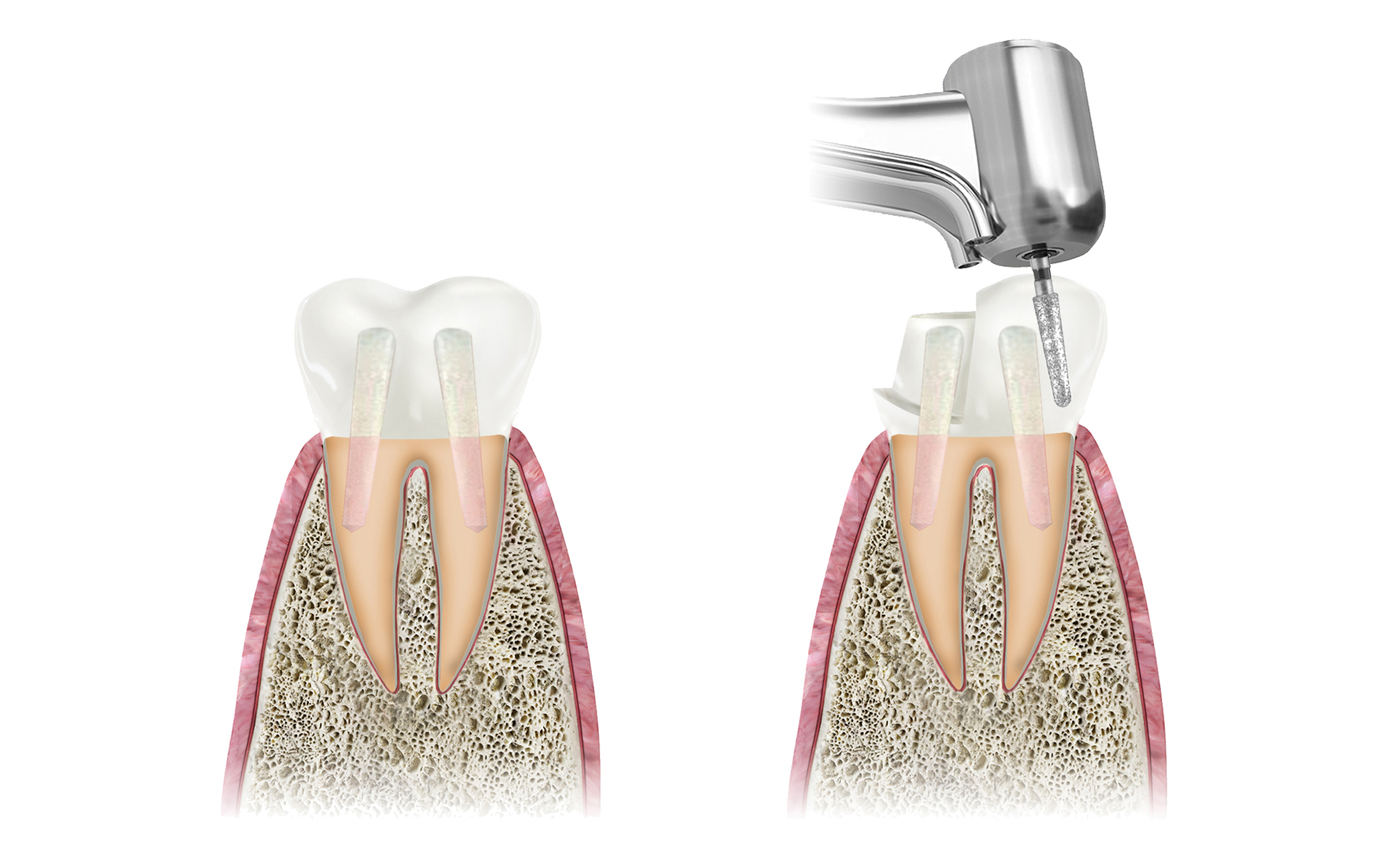
4. Filing down THE TOOTH UNDER A PROSTHETIC CROWN
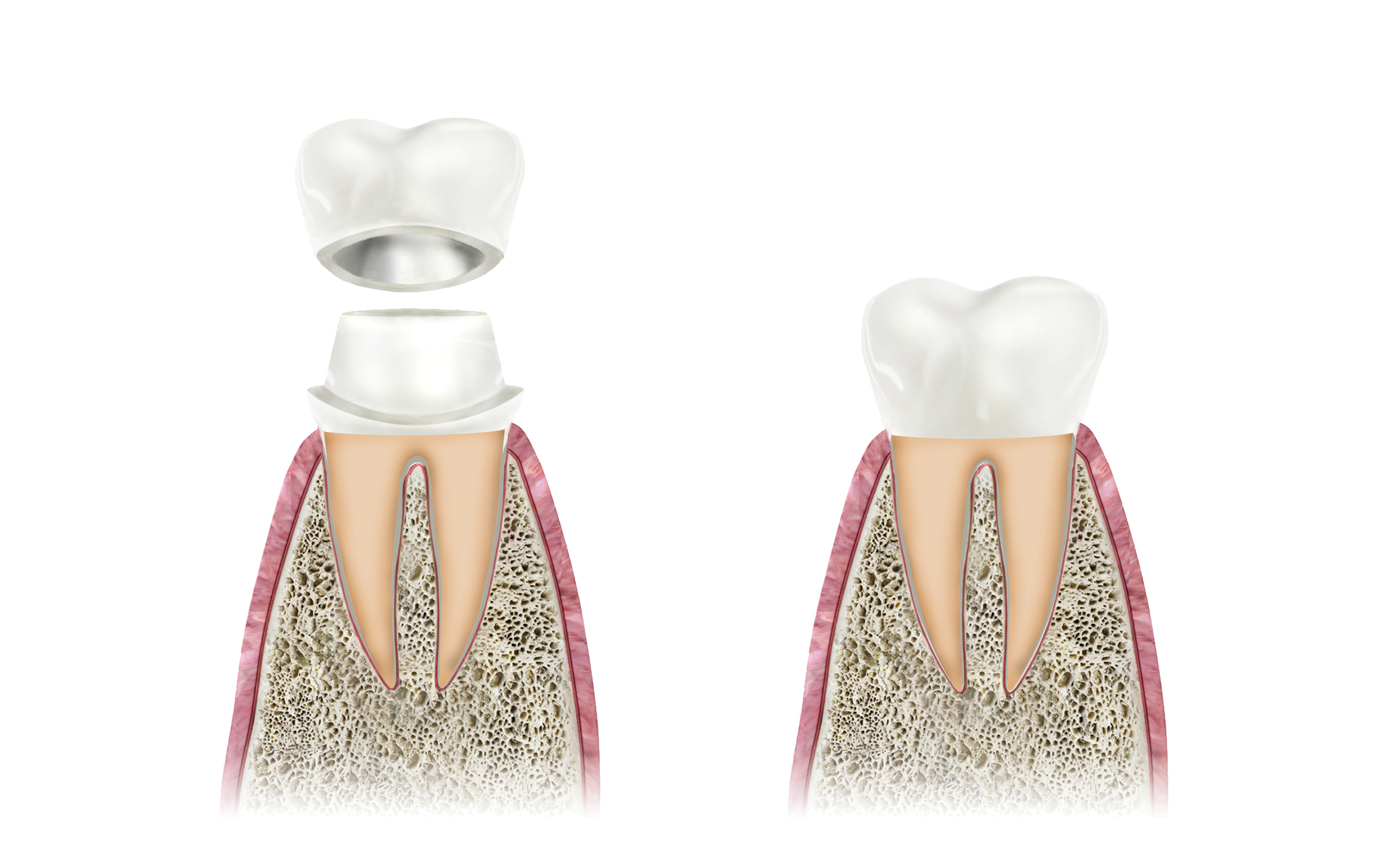
5. Placing THE CROWN
Frequently asked questions
Is root canal treatment painful?
Root canal treatments are carried out using anaesthesia, which means they are painless.
Will root canal treatment take place during one visit?
It depends on many factors, including:
• the number of tooth canals
• inflammation
• whether it is a primary or secondary treatment
Initial treatment lasts about 1 to 2 hours and can be carried out in one visit. However, secondary treatment will probably require additional visits.
Does root canal treatment ensure treatment success and tooth maintenance for many years?
It is estimated that root canal treatment has a 95% success rate. Failure can occur, which usually results from an unusual tooth structure, in particular the roots. Teeth treated endodontically usually have quite heavy losses of their own tissues. In order to strengthen their structure, it is generally advisable to apply an overlay or a porcelain crown on a crown-root insert, which ensures a durability comparable to the strength of a healthy tooth before treatment.
Will I need a crown after canal treatment?
It all depends on how much hard tissue is left after the treatment.
If the amount of tissue is low, a crown will probably be needed. If there is enough, it may be possible to make an overlay or regular filling.
Does the tooth hurt after the root canal treatment?
There may be slight pain after canal treatment, resulting mainly in tenderness of the tooth when biting. This originates from the development of the canals and does not indicate abnormal treatment. The tenderness can last from several hours to several days.
Does a tooth require radiological control after canal treatment?
Yes. After canal treatment, the tooth should be inspected radiologically after 3 months, 6 months and one year.
Will the tooth change colour and become dark after the root canal treatment?
In the past, yes, the treatment caused discolouration of the teeth. However, if the treatment is done properly – if all infected tissues are removed, and the canals filled with brand-new preparation – the tooth should not change colour.
Are there any special recommendations after root canal treatment?
There are usually no specific recommendations or specific contraindications after root canal treatment. Shortly after treatment, however, it is worth limiting consumption of hot food and drinks, and avoiding eating very hard foods or those that require intense chewing.
It turned out that I had a fractured instrument in the canal. Does this mean that I will have to remove the previously endodontically treated tooth?
Fortunately, no, thanks to the endodontic microscope, the doctor is able to remove the broken instrument.
What should be done to avoid the need for root canal treatment in the future?
Regular visits to the dental clinic should be carried out because early caries can be treated with a standard filling.











